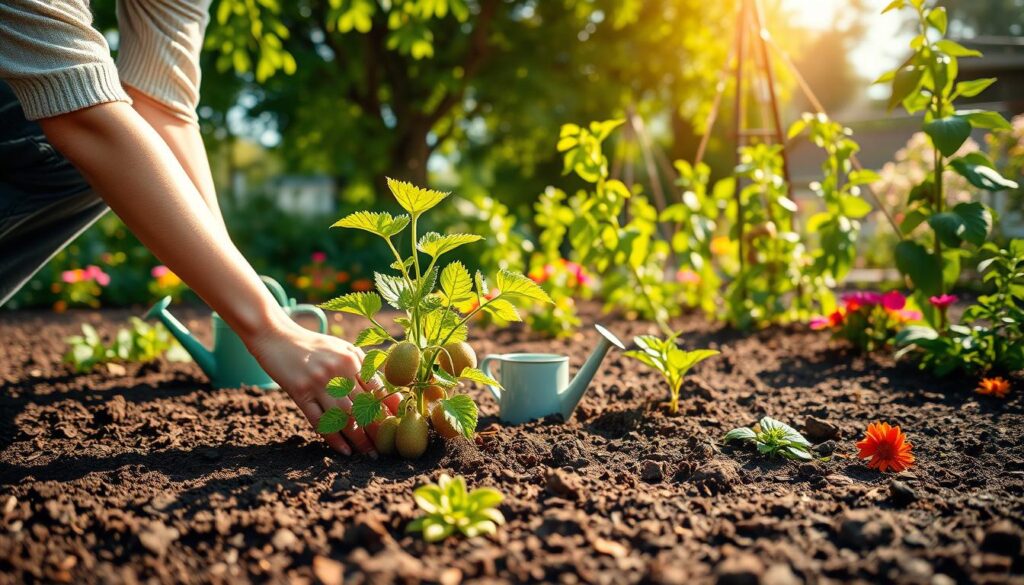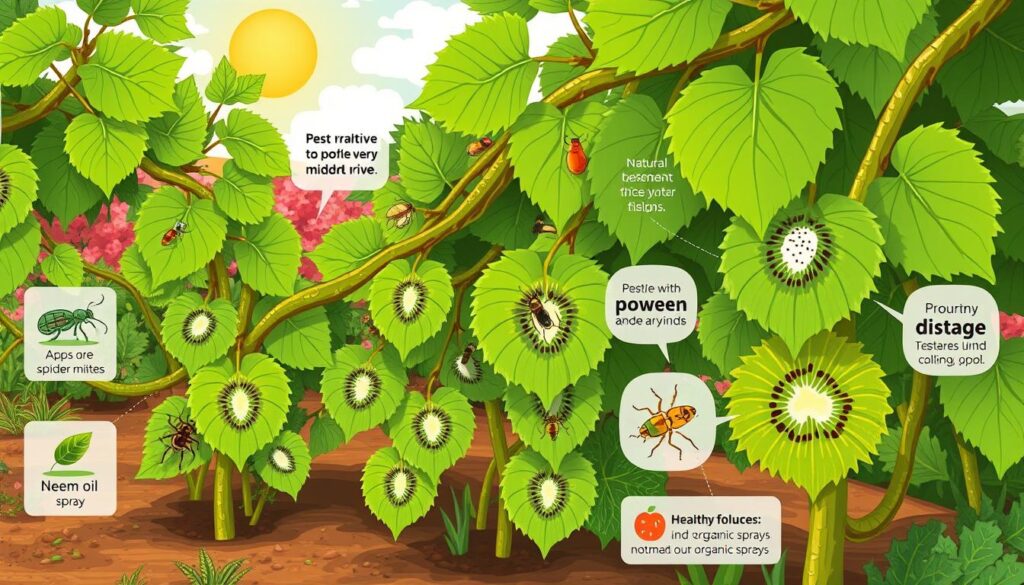Growing kiwi vines at home is a rewarding experience. It brings joy and the thrill of a bountiful harvest. This guide will share tips on growing these tasty vines. You’ll learn about kiwi varieties, planting, and care.
By the end, you’ll know how to grow kiwi vines at home. You’ll enjoy the fruits of your labor. For more help, visit GardenBeginner.com. It’s great for new gardeners.
Key Takeaways
- Kiwifruit plants thrive in areas with a frost-free growing season of at least 200 days.
- Both hardy kiwi and fuzzy kiwi varieties cater to different growing conditions.
- Spacing kiwi plants at 10 to 15 feet apart is crucial for optimal growth.
- Understanding the gender ratio of kiwi plants is essential for successful pollination.
- Proper kiwi vine care, including watering and fertilization, supports healthy growth and fruit production.
- Regular maintenance and timely pruning can significantly enhance your kiwi harvest.
- Kiwi fruits typically reach maturity in September and October, ready for harvesting.
Introduction to Growing Kiwi Vines
Growing kiwi vines is an exciting journey for gardeners. They bring lush foliage and sweet fruit to your garden. In this guide, we’ll cover the basics of growing kiwi vines, including the benefits and challenges.
Kiwi vines are strong climbers that need support. They’re perfect for vertical gardens. These plants also have beautiful flowers, making your garden look great.
Kiwi vines need the right soil and sunlight. They like a pH between 5.0 and 7.5 and need at least six hours of sun. Mulching helps keep the soil moist and controls weeds, improving fruit taste and yield.
Plant kiwi vines about 10 feet apart. For varieties that need pollination, plant one male for every eight females. These vines can grow heavy, producing 50 to 100 pounds of fruit each year.
Proper training and pruning are crucial for kiwi vines. They help manage growth and increase fruit production. Regular care is key to enjoying your kiwi plants.
If you’re interested in affiliate programs, check out this link. Your support through affiliate purchases helps us share valuable gardening tips.
Understanding Kiwi Varieties
When you think about growing kiwi, knowing the different types is key. There are hardy kiwi and fuzzy kiwi, each with its own needs and traits.
Hardy Kiwi (Actinidia arguta)
Hardy kiwi loves cold weather and grows well in USDA zones 3 to 8. It can handle temperatures as low as -25 degrees F. Some Russian varieties can even handle -35 degrees F.
The fruits are small, like grapes, and start growing in three to four years. The vines need to be eight years old to produce the most fruit. They can keep producing for up to forty years.
These vines can grow up to 40 feet tall, so they need strong supports. Plant one male vine for every eight or nine female vines. Keep plants ten to twelve feet apart for good growth and air flow.
Hardy kiwi needs regular pruning in winter and some in summer. They are also very pest-free and rarely need to be sprayed.
Fuzzy Kiwi (Actinidia deliciosa)
Fuzzy kiwi, or Actinidia deliciosa, grows the bigger fruits you see in stores. They like warmer weather, USDA zones 5 to 10. Their fruits are 3 to 5 centimeters with a fuzzy skin, loved by many.
When growing fuzzy kiwi, make sure the soil drains well and the spot is sunny and sheltered. They might need extra care in warmer places to avoid frost damage in spring.
For more tips on growing kiwi vines, check out this comprehensive guide. It has lots of planting and care advice.
| Characteristics | Hardy Kiwi | Fuzzy Kiwi |
|---|---|---|
| Cold Hardiness | -25°F (down to -35°F for some Russian varieties) | Warmer Climates (USDA zones 5-10) |
| Fruit Size | 1-2 inches | 3-5 inches |
| Growth Height | Up to 40 feet | Up to 26 feet |
| Time to Fruiting | 3-4 years | 3-4 years |
Choosing the Right Location for Your Kiwi Vines
Choosing the right spot for my kiwi vines is key to their success. The right conditions ensure they grow well and produce more fruit. This part talks about sun and soil needs for kiwi vines.
Sun Exposure and Sheltered Sites
Kiwi vines love full sun. They grow best when they get at least six hours of direct sunlight a day. In cooler places like South Dakota or Southwest Western Australia, I pick spots that are protected from frost and wind.
Planting near a south-facing wall helps too. It reflects heat, which is good for the vines.
Soil Requirements for Kiwi Vines
Kiwi vines need well-drained, fertile soil with lots of organic matter. A soil test shows if the pH is right; they do best in slightly acidic to neutral soil (pH 6-7). Places like Himachal Pradesh and Newcastle, NSW, show the need for good drainage.
Planting on mounds or ridges helps prevent roots from getting too wet. I always make sure my soil is right for the vines to grow well.
How to Plant and Care for Kiwi Vines at Home
Starting with planting kiwi vines was a big step for me. I learned that getting it right can make a huge difference. Knowing how to care for your kiwi vines is key to healthy plants and lots of fruit.
Preparing Your Planting Site
First, pick a spot that gets lots of sunlight. Kiwi vines love the sun. The soil should drain well and have lots of organic matter. Adding compost helps a lot. The soil’s pH should be between 5-6.5 for the best growth.
Best Practices for Planting Kiwi Vines
When planting kiwi vines, make sure the holes are big enough for the roots. Plant male and female vines close together for pollination. One male vine can pollinate up to eight females. Prune the vines in winter to encourage fruiting.
Spacing Between Plants
Spacing is very important for your vines’ health and fruit. Keep plants 10-12 feet apart for good air and sunlight. Kiwi vines can grow up to 30 feet tall and 20 feet wide. So, they need lots of room to grow without competing.

| Aspect | Recommended Practice |
|---|---|
| Soil Type | Well-drained with organic matter |
| Soil pH | 5-6.5 |
| Light Requirement | Full sun |
| Distance Between Vines | 10-12 feet |
| Pollination | 1 male to 8 female plants |
Kiwi Vine Care Essentials
Knowing how to care for kiwi vines is key to growing healthy, productive plants. Proper watering and fertilization are crucial for their growth and fruiting. Giving these areas the right attention leads to strong development and high yields.
Watering and Soil Moisture Management
Watering kiwi vines is essential, especially when they’re young or in dry weather. Keeping the soil moist helps the roots grow strong. They prefer loamy soil with good drainage and a pH of 5-7.
It’s important to check the soil moisture often. This prevents the vines from getting too wet, which can cause rot diseases.
Fertilization and Nutrient Needs
Kiwi vines need a lot of nitrogen to grow well. In the spring, after planting, I suggest using 10-10-10 fertilizer. This helps them grow and produce fruit.
Adding high-quality compost also gives them the nutrients they need. It improves the soil’s structure too.
| Fertilization Guidelines | Application Time | Amount |
|---|---|---|
| 10-10-10 Fertilizer | Spring (after planting) | 2 oz (57 g) per plant |
| High-Quality Compost | Seasonal (as needed) | Amend as required |
Creating a Support Structure for Kiwi Vines
Building a strong support for kiwi vines is key for their growth and fruit. Kiwi vines love to climb and need solid frames to reach the sun and get air. Using different trellis ideas can really help my kiwi plants grow well.
Types of Trellises and Supports
There are many trellis types that work well for kiwi vines. Here are some I like:
- Arched Trellises: They look good and let vines climb naturally.
- Horizontal Wire Systems: Multiple wires stretched out give great support.
- Wooden A-Frames: These frames are strong and let vines get lots of sun.
- Fences: Turning fences into supports makes them useful for growing kiwi vines.
The best system depends on the space and how I want my garden to look. A strong structure keeps vines supported as they grow fast.
How to Train Kiwi Vines on Supports
Training kiwi vines right is crucial for their growth. Here’s how I do it:
- Espalier Technique: This method helps vines grow out and get more sun.
- Single Trunk Training: I train one trunk first to make a strong “Y” shape with two main branches.
- Regular Pruning: Pruning in winter shapes the vine and controls growth. Shearing in growing season helps too.
Training kiwi vines takes time, about 4 to 5 years for good fruit. Being patient and consistent makes a beautiful, well-kept garden.
| Support Type | Benefits | Considerations |
|---|---|---|
| Arched Trellis | Boosts aesthetic appeal and maximizes space | Requires careful design and planning |
| Horizontal Wire System | Simple to install and maintain | Needs tight wire stretching for support |
| Wooden A-Frame | Durable and visually striking | Can be heavy; consider material quality |
| Fences | Utilizes existing structures effectively | Requires proper maintenance |
Kiwi Vine Maintenance and Pruning Techniques
Keeping kiwi vines healthy is key to a good harvest. Regular pruning helps them grow better and produce more fruit. Learning the right pruning techniques is crucial for a successful harvest.
Timing for Pruning Kiwi Vines
Prune kiwi vines in late winter to early spring. This is when they are dormant, making it easier to prune without harming buds. Pruning at this time helps the plants grow strong and produce more fruit.
Pruning Methods to Encourage Fruit Bearing
There are several pruning techniques to boost fruit production. I focus on:
- Dormant Pruning: Remove one-third of the fruiting laterals. This encourages new fruiting wood and keeps the plant vigorous.
- Branch Management: Trim side branches to keep them about 0.25 inches or more in diameter. This helps manage the vine’s shape and prevents overcrowding.
- Encouraging Buds: When pruning, head trained branches back to an upward-facing bud. This guides the plant’s growth.
- Regular Maintenance: Prune shoots off male kiwi vines shortly after flowering. This prevents overcrowding and lets both male and female plants thrive.
Using these pruning techniques helps my kiwi vines grow well and produce more. Each season, I see which methods work best and improve my pruning. These steps are key to a bountiful harvest in the future.
Protecting Your Kiwi Vines from Pests and Diseases
Keeping kiwi vines healthy means fighting pests and diseases early. Knowing about kiwi vine pests and using good disease management helps. This way, my plants stay strong and give lots of fruit.
Common Pests Affecting Kiwi Vines
Some pests are big threats to kiwi plants, including:
- Japanese beetles
- Leafroller caterpillars
- Mealybugs
- Aphids
These pests harm by eating leaves or roots. Using good bugs like ladybugs helps fight them. Regular checks help spot problems early, so I can act fast.
Managing Disease Risks in Kiwi Plants
Fungal diseases need my careful watch when protecting kiwi vines. Common ones are:
- Powdery mildew
- Root rot
- Botrytis blight
To fight these diseases, I use prevention like good soil and air. Sometimes, I need to spray with fungicides. Being proactive is key to keeping my kiwi vines healthy.

Harvesting Your Kiwi Fruit
Knowing when to pick kiwi fruit is key for the best taste. Kiwi is ready from late October to early November. During this time, its sugar content hits 6-8 percent, making it sweet.
Being able to spot when kiwi is ripe makes a big difference. It’s all about enjoying the sweet flavor.
When to Harvest Kiwi Fruit
A ripe kiwi feels soft. This is a clear sign it’s ready to eat. I check the sugar content, aiming for 6.5 percent or higher.
Letting kiwi vine-ripen can boost sugar to 12-15 percent. This is when it tastes the best. But, picking too early means it won’t be as sweet.
How to Store and Ripen Kiwi
Proper storage is vital after picking. If kiwi is hard, store it in a vented plastic bag in the fridge. This keeps it fresh for up to two months.
For longer storage, keep kiwis at 31 to 32 degrees F. They can last four to six months. Just keep them away from fruits that give off ethylene gas, as this can speed up ripening.
Once kiwi is ripe, eat it quickly. It doesn’t stay soft for long. Enjoying it right away ensures the best flavor and prevents waste.
By following these tips, I make sure my kiwi stays delicious for as long as possible. Harvesting at the right time and storing correctly are key.
Additional Tips for Growing Kiwi Vines
To grow kiwi vines well, I use smart planting friends and adjust care with the seasons. Good friends for plants help the soil and attract helpful bugs. Changing care with the seasons keeps my plants happy all year.
Companion Planting Suggestions
Planting friends can really help kiwi vines grow strong and produce more. Here are some great friends:
- Chives: Keep pests like aphids away and make the soil better.
- Nasturtium: Bring in good bugs and add color to the garden.
- Garlic: Keeps pests away and makes the soil richer.
I place these plants carefully around my kiwi vines. This helps them grow well and makes my garden lively.
Seasonal Care for Kiwi Vines
Knowing how to care for kiwi vines all year is key. Here’s what I do:
| Season | Care Practices |
|---|---|
| Spring | Check for frost damage and feed with a balanced fertilizer when new growth starts. |
| Summer | Water regularly, especially when it’s dry, and watch for pests. |
| Fall | Water well before the first frost to get plants ready for sleep. |
| Winter | Use horticultural fleece to protect young shoots from cold. |
By following these tips, I help my vines grow strong all year. This way, they can make lots of fruit.
Common Challenges and Solutions in Kiwi Vine Cultivation
Growing kiwi vines can be tricky, especially with weather and water issues. I’ve faced problems like frost damage and drought stress. These can hurt plant health and reduce fruit. Here’s how to tackle these problems.
Addressing Frost Damage
Frost damage is a big worry for kiwi vine growers, especially in early spring. Young shoots are very vulnerable to cold. To protect them, we can use a few strategies:
- Protective Covers: Row covers or blankets can shield plants from frost.
- Heat Retention Techniques: Heat lamps or water containers can warm the area around plants.
- Site Selection: Planting in sheltered spots, like near walls, helps protect from cold winds.
Managing Drought Stress
Drought stress is another big challenge for kiwi vines. They need moist soil to grow well. Signs include wilting leaves and slow growth. Here are some ways to manage it:
- Proper Irrigation: Regular, deep watering helps roots grow strong.
- Mulching: Mulch keeps soil moist and controls weeds.
- Soil Testing: Soil tests help find nutrient levels and improve water retention.
By adapting to these challenges, my kiwi vines can flourish and give healthy fruit. Knowing how to deal with frost damage and drought stress is key to a good harvest.
| Challenge | Signs | Solution |
|---|---|---|
| Frost Damage | Wilting shoots, discolored leaves | Use protective covers, heat retention techniques |
| Drought Stress | Wilting leaves, stunted growth | Regular irrigation, mulching, soil testing |
Conclusion
Growing kiwi vines at home needs careful attention and a good understanding of their needs. This guide has covered key practices for planting, caring for, and maintaining these plants. Each step, from choosing the right spot to using support structures, is important for success.
Hardy kiwi varieties like Actinidia arguta do well in many climates, making them great for home gardens. With the right sunlight, water, and pruning, my kiwi vines can grow a lot of fruit. Training them on trellises or pergolas helps them grow well and gives us lots of fruit.
If you’re starting to grow kiwi vines, I encourage you to follow these tips. With the knowledge from this guide, I’m sure you’ll grow successful kiwi vines. Enjoy the tasty fruit and the health benefits it brings.



Leave a Reply